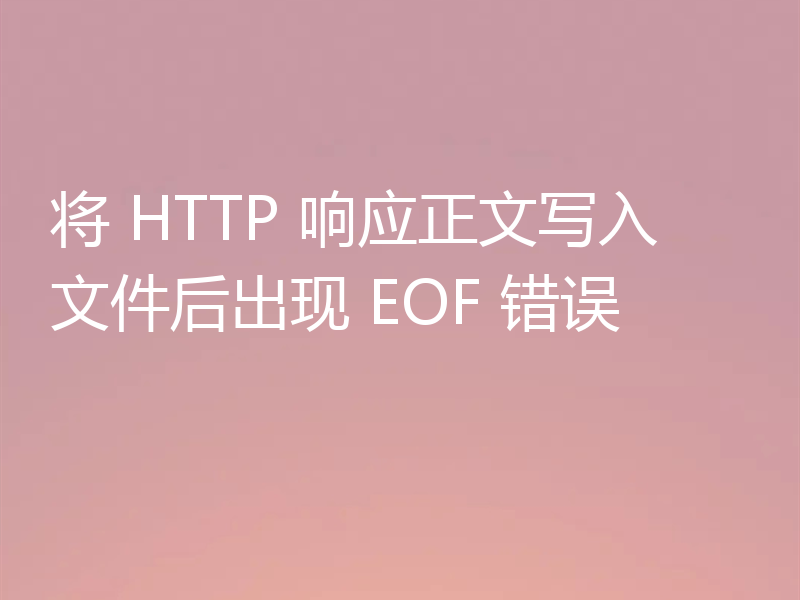通过 golang 中的多个 HTTP 处理程序包含上下文对象
怎么入门Golang编程?需要学习哪些知识点?这是新手们刚接触编程时常见的问题;下面golang学习网就来给大家整理分享一些知识点,希望能够给初学者一些帮助。本篇文章就来介绍《通过 golang 中的多个 HTTP 处理程序包含上下文对象》,涉及到golang,有需要的可以收藏一下
问题内容
我刚刚阅读了这篇关于创建函数类型并在该函数上实现方法以处理错误的[博客文章。](http://blog.golang.org/error-handling-
and-go#TOC_3.).ServeHTTP()例如:
type appError struct {
Error error
Message string
Code int
}
type appHandler func(http.ResponseWriter, *http.Request) *appError
func (fn appHandler) ServeHTTP(w http.ResponseWriter, r *http.Request) {
if e := fn(w, r); e != nil { // e is *appError, not os.Error.
http.Error(w, e.Message, e.Code)
}
}
func init() {
http.Handle("/view", appHandler(viewRecord)) //viewRecord is an appHandler function
}
我喜欢这种方法,但我无法从概念上弄清楚如何通过处理程序层包含上下文对象。例如:
func init() {
http.Handle("/view", AuthHandler(appHandler(viewRecord)))
}
AuthHandler可能会为每个请求创建一个&SessionToken{User: user}对象并将其设置在context.Context对象中。我不知道如何把它交给viewRecord处理程序。想法?
正确答案
我可以想到几种方法来做到这一点。
传递上下文
首先,您可以更改签名以接受上下文
type appHandler func(http.ResponseWriter, *http.Request, context.Context) *appError
func (fn appHandler) ServeHTTP(w http.ResponseWriter, r *http.Request) {
if e := fn(w, r, nil); e != nil { // e is *appError, not os.Error.
http.Error(w, e.Message, e.Code)
}
}
现在我假设 AuthHandler 与身份验证有关,并在上下文对象中设置用户。
您可以做的是创建另一个设置上下文的类型处理程序。像这样
type authHandler func(http.ResponseWriter, *http.Request, context.Context) *appError
func (fn authHandler) ServeHTTP(w http.ResponseWriter, r *http.Request) {
// setup authentication here
uid := 1
// setup the context the way you want
parent := context.TODO()
ctx := context.WithValue(parent, userIdKey, uid)
if e := fn(w, r, ctx); e != nil { // e is *appError, not os.Error.
http.Error(w, e.Message, e.Code)
}
}
这样你就可以通过以下方式使用它
func init() {
http.Handle("/view", appHandler(viewRecord)) // don't require authentication
http.Handle("/viewAuth", authHandler(viewRecord)) // require authentication
}
这是完整的代码
package main
import (
"fmt"
"net/http"
"code.google.com/p/go.net/context"
)
type appError struct {
Error error
Message string
Code int
}
type key int
const userIdKey key = 0
type appHandler func(http.ResponseWriter, *http.Request, context.Context) *appError
func (fn appHandler) ServeHTTP(w http.ResponseWriter, r *http.Request) {
if e := fn(w, r, nil); e != nil { // e is *appError, not os.Error.
http.Error(w, e.Message, e.Code)
}
}
type authHandler func(http.ResponseWriter, *http.Request, context.Context) *appError
func (fn authHandler) ServeHTTP(w http.ResponseWriter, r *http.Request) {
// setup authentication here
uid := 1
// setup the context the way you want
parent := context.TODO()
ctx := context.WithValue(parent, userIdKey, uid)
if e := fn(w, r, ctx); e != nil { // e is *appError, not os.Error.
http.Error(w, e.Message, e.Code)
}
}
func viewRecord(w http.ResponseWriter, r *http.Request, c context.Context) *appError {
if c == nil {
fmt.Fprintf(w, "User are not logged in")
} else {
uid := c.Value(userIdKey)
fmt.Fprintf(w, "User logged in with uid: %d", uid)
}
return nil
}
func init() {
http.Handle("/view", appHandler(viewRecord)) // viewRecord is an appHandler function
http.Handle("/viewAuth", authHandler(viewRecord)) // viewRecord is an authHandler function
}
func main() {
http.ListenAndServe(":8080", nil)
}
创建地图上下文
您无需传递上下文,而是创建
var contexts map[*http.Request]context.Context
view并在with中获取上下文contexts[r]。
但是由于 map 不是线程安全的,所以必须使用互斥锁来保护对 map 的访问。
猜猜看,这就是 gorilla context 正在为你做的事情,我认为这是更好的方法
https://github.com/gorilla/context/blob/master/context.go#l20-28
这是完整的代码
package main
import (
"fmt"
"net/http"
"github.com/gorilla/context"
)
type appError struct {
Error error
Message string
Code int
}
type key int
const userIdKey key = 0
type appHandler func(http.ResponseWriter, *http.Request) *appError
func (fn appHandler) ServeHTTP(w http.ResponseWriter, r *http.Request) {
if e := fn(w, r); e != nil { // e is *appError, not os.Error.
http.Error(w, e.Message, e.Code)
}
}
type authHandler func(http.ResponseWriter, *http.Request) *appError
func (fn authHandler) ServeHTTP(w http.ResponseWriter, r *http.Request) {
// setup authentication here
uid := 1
context.Set(r, userIdKey, uid)
if e := fn(w, r); e != nil { // e is *appError, not os.Error.
http.Error(w, e.Message, e.Code)
}
}
func viewRecord(w http.ResponseWriter, r *http.Request) *appError {
if uid, ok := context.GetOk(r, userIdKey); !ok {
fmt.Fprintf(w, "User are not logged in")
} else {
fmt.Fprintf(w, "User logged in with uid: %d", uid)
}
return nil
}
func init() {
http.Handle("/view", appHandler(viewRecord)) // don't require authentication
http.Handle("/viewAuth", authHandler(viewRecord)) // require authentication
}
func main() {
http.ListenAndServe(":8080", nil)
}
您还可以选择包装函数而不是类型函数进行身份验证
func AuthHandler(h appHandler) appHandler {
return func(w http.ResponseWriter, r *http.Request) *appError {
// setup authentication here
uid := 1
context.Set(r, userIdKey, uid)
return h(w, r)
}
}
func init() {
http.Handle("/view", appHandler(viewRecord)) // don't require authentication
http.Handle("/viewAuth", appHandler(AuthHandler(viewRecord))) // require authentication
}
到这里,我们也就讲完了《通过 golang 中的多个 HTTP 处理程序包含上下文对象》的内容了。个人认为,基础知识的学习和巩固,是为了更好的将其运用到项目中,欢迎关注golang学习网公众号,带你了解更多关于golang的知识点!
 Go 语言将模数指数转换为 X.509 证书
Go 语言将模数指数转换为 X.509 证书
- 上一篇
- Go 语言将模数指数转换为 X.509 证书

- 下一篇
- 静态成员变量,例如 OOP 语言
-

- Golang · Go问答 | 1年前 |
- 在读取缓冲通道中的内容之前退出
- 139浏览 收藏
-

- Golang · Go问答 | 1年前 |
- 戈兰岛的全球 GOPRIVATE 设置
- 204浏览 收藏
-

- Golang · Go问答 | 1年前 |
- 如何将结构作为参数传递给 xml-rpc
- 325浏览 收藏
-

- Golang · Go问答 | 1年前 |
- 如何用golang获得小数点以下两位长度?
- 478浏览 收藏
-

- Golang · Go问答 | 1年前 |
- 如何通过 client-go 和 golang 检索 Kubernetes 指标
- 486浏览 收藏
-

- Golang · Go问答 | 1年前 |
- 将多个“参数”映射到单个可变参数的习惯用法
- 439浏览 收藏
-

- Golang · Go问答 | 1年前 |
- 将 HTTP 响应正文写入文件后出现 EOF 错误
- 357浏览 收藏
-

- Golang · Go问答 | 1年前 |
- 结构中映射的匿名列表的“复合文字中缺少类型”
- 352浏览 收藏
-

- Golang · Go问答 | 1年前 |
- NATS Jetstream 的性能
- 101浏览 收藏
-

- Golang · Go问答 | 1年前 |
- 如何将复杂的字符串输入转换为mapstring?
- 440浏览 收藏
-

- Golang · Go问答 | 1年前 |
- 相当于GoLang中Java将Object作为方法参数传递
- 212浏览 收藏
-

- Golang · Go问答 | 1年前 |
- 如何确保所有 goroutine 在没有 time.Sleep 的情况下终止?
- 143浏览 收藏
-

- 前端进阶之JavaScript设计模式
- 设计模式是开发人员在软件开发过程中面临一般问题时的解决方案,代表了最佳的实践。本课程的主打内容包括JS常见设计模式以及具体应用场景,打造一站式知识长龙服务,适合有JS基础的同学学习。
- 542次学习
-

- GO语言核心编程课程
- 本课程采用真实案例,全面具体可落地,从理论到实践,一步一步将GO核心编程技术、编程思想、底层实现融会贯通,使学习者贴近时代脉搏,做IT互联网时代的弄潮儿。
- 511次学习
-

- 简单聊聊mysql8与网络通信
- 如有问题加微信:Le-studyg;在课程中,我们将首先介绍MySQL8的新特性,包括性能优化、安全增强、新数据类型等,帮助学生快速熟悉MySQL8的最新功能。接着,我们将深入解析MySQL的网络通信机制,包括协议、连接管理、数据传输等,让
- 498次学习
-

- JavaScript正则表达式基础与实战
- 在任何一门编程语言中,正则表达式,都是一项重要的知识,它提供了高效的字符串匹配与捕获机制,可以极大的简化程序设计。
- 487次学习
-

- 从零制作响应式网站—Grid布局
- 本系列教程将展示从零制作一个假想的网络科技公司官网,分为导航,轮播,关于我们,成功案例,服务流程,团队介绍,数据部分,公司动态,底部信息等内容区块。网站整体采用CSSGrid布局,支持响应式,有流畅过渡和展现动画。
- 484次学习
-

- 千音漫语
- 千音漫语,北京熠声科技倾力打造的智能声音创作助手,提供AI配音、音视频翻译、语音识别、声音克隆等强大功能,助力有声书制作、视频创作、教育培训等领域,官网:https://qianyin123.com
- 217次使用
-

- MiniWork
- MiniWork是一款智能高效的AI工具平台,专为提升工作与学习效率而设计。整合文本处理、图像生成、营销策划及运营管理等多元AI工具,提供精准智能解决方案,让复杂工作简单高效。
- 217次使用
-
- NoCode
- NoCode (nocode.cn)是领先的无代码开发平台,通过拖放、AI对话等简单操作,助您快速创建各类应用、网站与管理系统。无需编程知识,轻松实现个人生活、商业经营、企业管理多场景需求,大幅降低开发门槛,高效低成本。
- 214次使用
-

- 达医智影
- 达医智影,阿里巴巴达摩院医疗AI创新力作。全球率先利用平扫CT实现“一扫多筛”,仅一次CT扫描即可高效识别多种癌症、急症及慢病,为疾病早期发现提供智能、精准的AI影像早筛解决方案。
- 218次使用
-
- 智慧芽Eureka
- 智慧芽Eureka,专为技术创新打造的AI Agent平台。深度理解专利、研发、生物医药、材料、科创等复杂场景,通过专家级AI Agent精准执行任务,智能化工作流解放70%生产力,让您专注核心创新。
- 239次使用
-
- 老师代码没有自动跟踪?
- 2023-03-07 439浏览
-
- c程序fork并等待golang进程状态
- 2023-03-05 262浏览
-
- GOLANG使用Context管理关联goroutine的方法
- 2022-12-28 193浏览
-
- 怎么用Golang将MySQL表转储为JSON
- 2023-03-07 188浏览
-
- Golang 检查字符串是否为有效路径?
- 2023-03-10 500浏览



